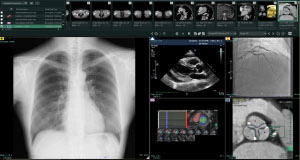I spent the first part of my career as a radiologic technologist, and the last 23 years in the commercial diagnostic imaging industry – most recently as an enterprising imaging marketing manager for FUJIFILM Medical Imaging Systems, U.S.A., Inc. (FMSU). During this time, I’ve seen how informatics and image management technology have evolved and have a few predictions about where it’s headed.
Radiology picture archiving and communication systems – or “PACS” – originally focused on imaging for one primary service line: radiology. However, as the technology continued to advance, it became apparent that it could do something greater by acting as a comprehensive enterprise imaging system. Have you considered if your PACS technology can provide access to imaging and multimedia content throughout the entire organization? Wouldn’t that give a better representation of the full patient health picture and, as a result, help drive better care decisions?
The PACS of tomorrow will have that kind of complete interconnectivity, while building upon the benefits that server-side rendering introduced back in the mid-2010s. This modernized blueprint of a single PACS platform will encompass all facets of enterprise imaging software – including Cardiology PACS, a Vendor Neutral Archive, 3D advanced visualization, Enterprise Information Systems (EIS), Cloud, and Artificial Intelligence – as well as the essential support that each system requires.

I know what you might be wondering: if I’m thinking back more than 20 years, to a time when we didn’t even have PACS at my particular workplace, how can I possibly know that’s where the future of the technology should – or even can – go? Well, because at FMSU, we pride ourselves on working directly with our customers to optimize our technology. We engage with them, listen to their ideas and opinions, and take that insight to R&D to build a more innovative PACS product – one that not only improves our customers’ user experience, but more importantly improves their patient care. That degree of customer collaboration intensified when we redirected engineering to a server-based PACS platform, and it will intensify again as we work with them to bring their desire for a single, unified PACS platform to market.
A critical piece of that single PACS platform needs to be artificial intelligence – or “AI.” Undoubtedly, all PACS vendors will eventually embrace AI, or risk being left behind. The demand to read more images per study is growing rampantly, but the number of radiologists is not. On top of that, the complexity of new imaging breakthroughs triggers the need for an AI co-pilot that can help take on some of these overwhelming imaging obligations.
We know that AI will automate the time-consuming and sometimes monotonous tasks that radiologists face; we know it will detect life-threatening issues and notify care teams to prioritize a patient case; we know it will consistently track changes to each patient’s health status and deliver the supplementary health data directly to the user. The result is unprecedented workflow productivity, efficiency, and more informed decisions. But truthfully, it’s what we don’t know about AI – what its full potential will be for the way we diagnose, treat, and care for patients – that holds the most promise, not just for enterprise imaging, but for healthcare as a whole.
The healthcare landscape will never stop evolving, and the field of enterprise imaging is no exception. So it’s critical that technology evolves with it. Working in collaboration with radiologists on the frontlines, FMSU will continue to advance its enterprise imaging technology to meet the needs of our customers. And as for a unified PACS platform, well, let’s just say FMSU is ready to bring the potential of tomorrow to providers today.